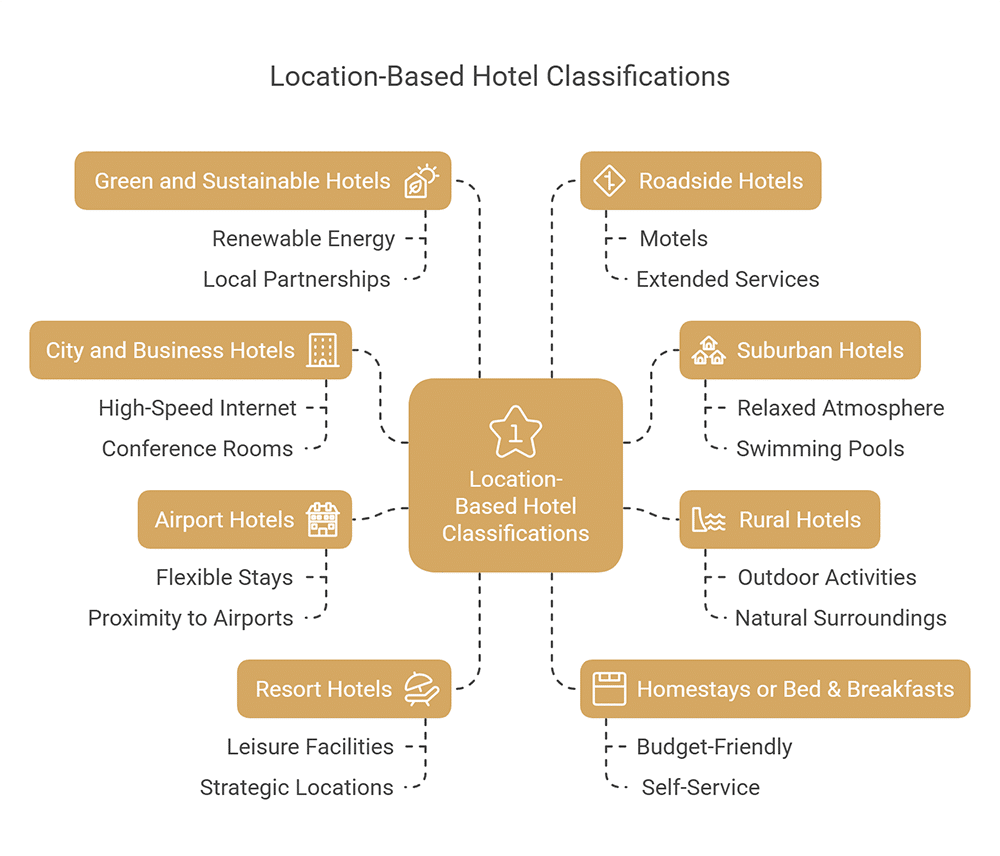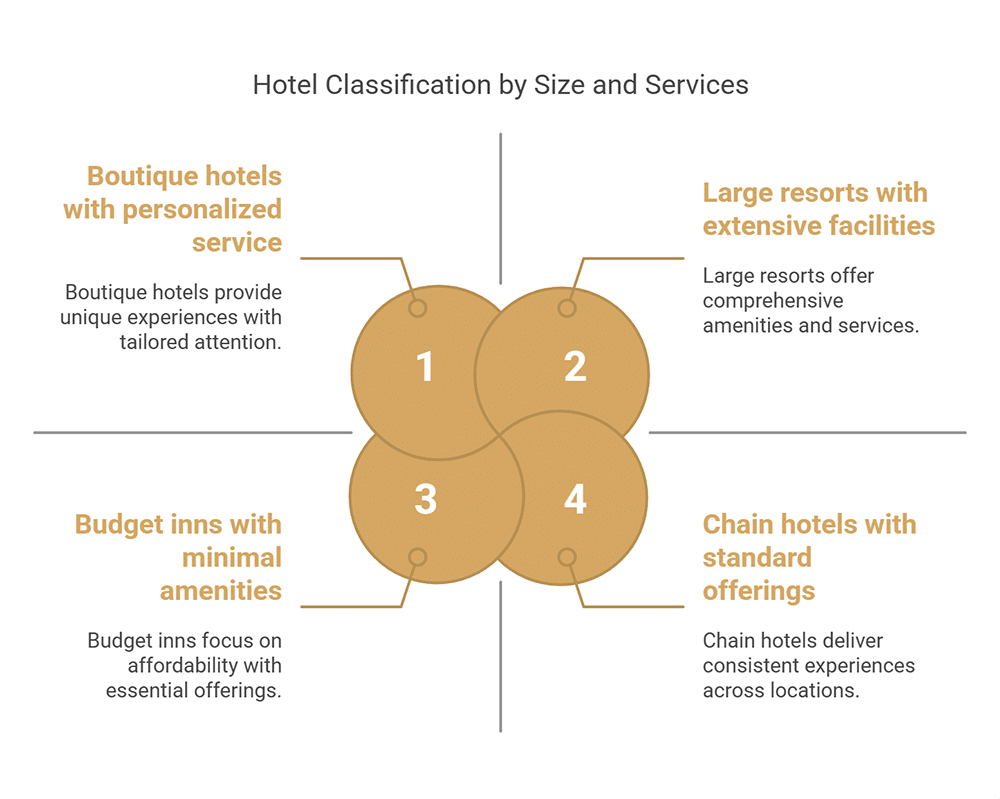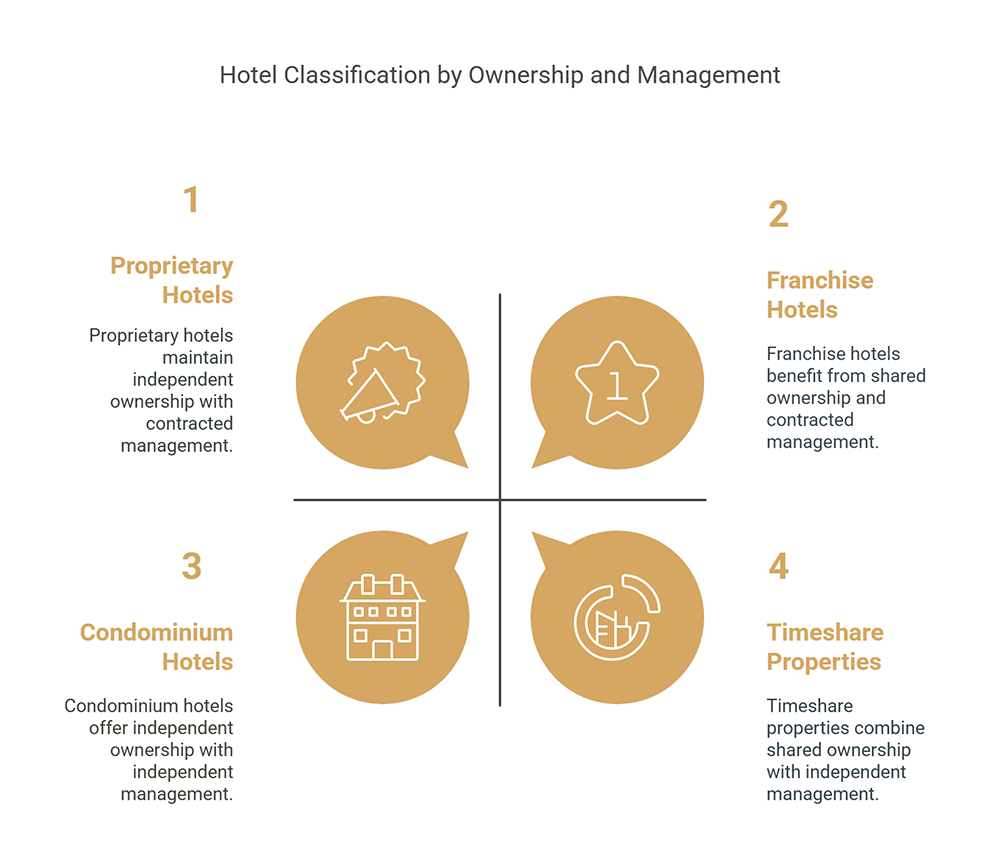Hotel classifications are used to categorize hotels, based on their size, location, quality level, services, amenities or facilities. Classifying hotels in this way can help to manage expectations and set industry standards.
The importance of hotel classifications primarily lies in guest expectation management. For example, a guest booking a 5-star hotel will expect exceptional service, while a guest booking a 1-star hotel will expect only basic standards.
In this article, you can examine what hotel classifications are, explore the different hotel types within the industry, and gain an appreciation for why this categorization of hotels really matters.
Table of Contents:
- Understanding Hotel Classifications
- The Importance of Hotel Classifications
- A Complete Guide to Star Rating Hotel Classifications
- Exploring Location-Based Hotel Classifications
- An Overview of Size-Based Hotel Classifications
- Hotel Classifications by Length of Stay
- Hotel Classifications By Ownership and Management Structure
- Key Guidelines for Hotel Classifications
- Comprehensive Comparison of Hotel Classifications
- A Guide to Hotel Room Types
- Exploring the Main Types of Hotels
Understanding Hotel Classifications
Hotel classifications are categories used to group hotels together based on shared traits. The classification of hotels can occur according to strict criteria, but some categories may be more loosely defined.
Examples of relevant traits may include the size of the hotel, its ownership structure, or the quality level achieved. Hotels can also be classified based on the services and amenities they offer, or the facilities in the hotel.
A single hotel can be classified in numerous ways. For instance, you could have a 5-star hotel that is also classified as a business hotel, or a long-stay hotel that is also classed as a suburban hotel.
The Importance of Hotel Classifications
Hotel classifications are important for managing quality standards throughout the hotel industry. In addition, accurate classification of hotel businesses helps to manage guest expectations around service standards.
When different hotel types are grouped together, based on shared characteristics, more useful comparisons can be made. Comparing two small hotels often makes more sense than comparing a small hotel to a large, 5-star resort.
A logical hotel classification system also allows guests to make more informed booking decisions. For instance, knowing that a hotel is classed as a business hotel can make it much easier for corporate travelers to book a suitable hotel.
A Complete Guide to Star-Rating Hotel Classifications
In these sections, you can explore what each star rating hotel classification means in greater depth and start to build a picture of why these star ratings matter to hotels and their guests.
1-Star Hotel Classification
A 1-star hotel is the most rudimentary of the star-rating hotel classifications in the industry. It represents simple accommodation, with basic service standards, while still retaining high standards for cleanliness.
Basic hotels play an important role in the industry, providing guests with simple options to cover the most essential needs. These properties will typically lack extra amenities, but charge lower prices as a result.
A 1-star hotel will often be a smaller, independent hotel, rather than part of a chain. These properties may operate with a limited number of employees and target the most budget-conscious travelers.
2-Star Hotel Classification
A 2-star hotel will provide a clear step up in services when compared to 1-star properties. These hotels will usually offer basic food services and will deliver a higher level of comfort for guests.
Within the wider context of hotel classifications, the main role of 2-star hotels is to provide budget-friendly accommodation that goes beyond the most basic hotels. These hotels can appeal to leisure and business travelers alike.
Guests can expect a hotel that offers some level of housekeeping, along with limited additional services or amenities. In some hotels, guests will be required to pay more to access some of these extra features.
3-Star Hotel Classification
A 3-star hotel offers guests a combination of quality service and a high level of comfort, while still prioritizing affordability. It represent the mid-point in star ratings-based hotel classifications.
Generally, 3-star hotels serve as a great compromise option for guests, who may want comfort and extra features, but may not want to pay for 5-star luxury. A 3-star hotel will meet the expectations of most guests.
Within this classification of hotel, you will find a decent range of amenities and very good service standards. Many of these hotels are mid-size to large hotels and may provide meeting rooms and other business services.
4-Star Hotel Classification
Within the field of hotel classifications, the 4-star level is often viewed as a deluxe or upscale guest experience. These hotels will offer extensive services and amenities and provide excellent comfort.
The 4-star rating plays a key role in bridging the gap between the most luxurious hotels and the 3-star mid-level offerings. These hotels will meet and even exceed most guests’ needs, with responsive, well-trained staff.
At this level of service, hotels usually deliver some personalization, meaning services are tailored to individuals. The 4-star level also marks the point at which service and features become more important than price to guests.
5-Star Hotel Classification
A hotel that achieves the 5-star hotel classification is a luxury hotel, with exceptional service standards. These hotels go above and beyond to deliver an experience that exceeds the majority of guests’ expectations.
Within the industry, 5-star hotels are the gold standard. These hotels will offer world-class facilities and amenities, excellent service, and a high level of personalization too.
Attention to detail goes to the next level and guests can expect to see unique design features, expensive furnishings, and high-end technology. Luxury offerings may also include spa services and 24/7 room service.
Video: HOW ARE HOTELS RATED? 5 STAR RATINGS EXPLAINED | Differences between 1, 2, 3, 4 and 5 star hotels
7-Star Hotel Classification
A 7-star hotel is a marketing concept, used to indicate that a hotel goes beyond the level of a 5-star hotel. These hotels are not officially recognized as 7-star hotels by bodies offering official hotel classifications.
Regardless of any official classification, the 7-star tag can be useful for indicating to guests that the hotel offers a truly exceptional service standard. It also sets a clear expectation that the hotel will be more expensive.
Some of the features you might find in a hotel that has been described as a 7-star hotel include personal butlers, luxury transportation services, next-level personalization and world-class on-site restaurants.
Exploring Location-Based Hotel Classifications
Here, you can learn all about how location can be used as part of a hotel classification system.
City and Business Hotels
City hotels and business hotels are hotels located in city centers, business districts or other busy urban areas. They are among the hotel classifications most likely to offer high-speed internet and conference or meeting rooms.
These hotels are one of the biggest individual segments of the hotel industry. They tend to benefit from excellent transport links and can appeal to corporate travelers and leisure travelers alike.
Many of these hotels will feature executive suites, robust room service options, and strong relationships with local taxi services. In addition, some urban hotels are boutique hotels, with an intimate feel and unique design elements.
Suburban Hotels
Suburban hotels are located on the outskirts of major cities, often benefiting from greater availability of land. This can sometimes allow them to offer a more relaxed atmosphere, with amenities like swimming pools.
These hotels serve an important purpose, often appealing to the more budget-conscious traveler, while providing at least some of the convenience of a city hotel. They may also feature larger rooms than city center hotels.
In many cases, suburban hotels get to benefit from multiple aspects of other location-based hotel classifications. For instance, they can charge lower prices than city center hotels, while still providing easy access to the city.
Rural Hotels
Rural hotels are situated away from urban areas, in the countryside or near natural attractions. They can include a wide range of service levels, but tend to facilitate outdoor activities and offer natural surroundings.
Of all the hotel classifications, rural hotels look set for a very bright future. They play a key role in promoting ecotourism and sustainable travel, while also appealing to those interested in slow tourism or rural tourism.
Many rural hotels focus on creating a pleasant, welcoming environment, with more limited additional services. They often operate with fewer staff than the chain hotels found in and around major metropolitan areas.
Airport Hotels
Airport hotels are situated either within an airport, or very close to an airport. These hotels serve a very specific function, providing accommodation to travelers who need somewhere to stay before or after a flight.
These hotels not only provide important accommodation options, they help to facilitate further travel. This makes airport hotels a cornerstone of the modern travel industry, as well as a hotel type that needs to meet specific needs.
Compared with many other hotel classifications, airport hotels are usually intended to facilitate shorter stays, often for a single night. They also provide true flexibility around check-in and check-out times.
Video: Welcome to the Marriott Frankfurt Airport Hotels
Resort Hotels
Resort hotels are hotels that offer a complete vacation experience in a single place. They usually offer all-inclusive options, on-site shops, restaurants and entertainment, and a variety of leisure facilities.
Many guests choose to visit resorts to escape everyday stress, knowing all of their needs can be catered for without needing to leave the resort. However, resorts may also be connected to major attractions, like theme parks.
Most resorts are large in scale and situated away from city centers. They may also be strategically located near beaches, ski slopes, nature trails, golf courses or other features that can add to their appeal.
Homestays or Bed & Breakfasts
Bed & breakfasts are small-scale accommodation businesses, often located in old pubs or private homes, with live-in owners. Homestays, on the other hand, are private homes, offered as a temporary place to stay for travelers.
Unlike many other hotel classifications, the properties in this category prioritize the “home away from home” feel. They can also offer budget-friendly accommodation, or a place to stay when hotels are not available in the area.
The primary difference is in service standards. While a bed & breakfast will provide some level of guest services, including housekeeping and food and beverages, homestays are offered on more of a self-service basis.
Green and Sustainable Hotels
Green and sustainable hotels are hotels prioritizing the environment and the long-term future of the hotel industry. For this reason, they are often located near areas of natural beauty and will feature energy-efficient services.
The rise of sustainable travel has been one of the single most important hotel trends of recent times. With greater demand for travel that limits harm to the environment, this has become one of the fastest-rising hotel classifications.
Green and sustainable hotels often have partnerships with local suppliers and work with the community to create mutually beneficial relationships. They may also make use of renewable energy sources and aim to limit waste.
Roadside Hotels
Roadside hotels are, as the name indicates, hotels situated along major travel routes. They are designed to accommodate the needs of motorists on road trips or longer car journeys and include motels and larger hotels.
This hotel classification is especially common in vast countries, where journeys between towns and cities can take many hours. They serve a vital role in facilitating long distance road travel and road trip vacations.
Historically, most of these properties have been motels, with basic services and direct access to rooms from the parking lot. However, more recently, larger hotels with more extensive services have become popular too.
An Overview of Size-Based Hotel Classifications
One of the easiest approaches to creating hotel classifications is to categorize hotels according to their size. More specifically, this kind of hotel classification system is usually based on the number of rooms in a hotel.
Small Hotels (0-25 Rooms)
Small hotels are typically classed as hotels with up to 25 rooms. They can vary from budget accommodation, through to luxury boutique hotels, but they are often budget-oriented and independently owned.
Small hotels have their own niche in the hotel industry. Their smaller scale and the relatively low number of guests can sometimes mean they offer a greater level of personal interaction with each guest.
Given their size, small hotels can appear in a variety of locations. It is common for small hotels to be established in and around cities, in rural areas, or near attractions or places of interest to travelers.
Medium-Sized Hotels (26-300 Rooms)
Medium-sized hotels are usually defined as hotels with more than 25 rooms and a maximum of 300 rooms. This allows the hotels to offer a wider range of facilities and amenities than smaller hotels.
The medium-sized hotel classification makes up the largest percentage of the industry. It encompasses a wide range of hotel types, including boutique hotels, chain hotels and extended-stay hotels.
In many ways, medium-sized hotels represent a sweet spot between the facilities on offer and the level of individual attention guests can receive. The properties themselves, however, can target vastly different customer groups.
Large Hotels (300+ Rooms)
Large hotels are generally defined as hotels with more than 300 rooms. They are often large-scale resorts or hotels with rooms on many different floors and they offer a large range of facilities.
Of all of the size-based hotel classifications, large hotels are the most complicated to manage on an operational level. They employ a large number of staff, have many rooms to turnover and typically have on-site restaurants.
Large hotels will often have extensive corporate facilities and may also host events, including weddings. They may have dedicated bridal or honeymoon suites and provide a variety of entertainment options on-site.
Hotel Classifications by Length of Stay
Some hotel classifications are determined by the length of stay on offer. Hotels may specifically target guests who have needs outside of the norm, while others accommodate a variety of stay lengths. Here, you can read about some of the hotel categories that are based on stay length.
Transient or Short-Stay Hotels
Short-stay hotels target guests who only want to stay for a short period of time. Many of these guests are considered ‘transient’ customers, meaning they travel alone, often book on short notice and prefer short stays.
It is important for the hotel industry to provide options for guests who need to find a place to stay urgently. Some guests also require a hotel for a single night, a couple of nights, or even just for during the day.
One of the key features of hotel classifications targeting transient guests is flexibility. These guests may turn up without making a reservation and may want to check in or check out at unusual hours.
Medium Stay Hotels
Medium stay hotels are geared towards demographics that will stay in the hotel for around a week or two. This includes hotels that target vacation travelers, like couples, families and solo travelers.
Most hotels are able to facilitate medium length stays, but some specifically aim for this length of stay. This allows them to tailor services around this, including housekeeping.
A variety of hotel classifications fall under this umbrella, including 5-star hotels and resorts. These hotels will usually provide a variety of services, including leisure options and some degree of on-site entertainment.
Extended Stay Hotels
Extended stay hotels and apartments are set up to accommodate guests who need to stay for longer than two weeks. This can include three-week or four-week stays and sometimes includes even longer stays.
The extended stay hotel market serves a valuable role, providing options for people who need to be away from home for weeks at a time. This might include business travelers, refugees and digital nomads.
Often, long stay hotels will deliver an environment that resembles a home, with distinct bedrooms, kitchens, living rooms and bathrooms. On-site laundry facilities are a must and some of these hotels also offer on-site shops.
Hotel Classifications By Ownership and Management Structure
Hotel categories can also be determined based on who owns the hotel or the management structure.
Private or Proprietary Ownership
Proprietary ownership describes hotels that are owned or managed independently, without the involvement of a parent company or chain. They may be single-owner businesses, under family ownership or owned by a small group of people.
A private ownership structure provides complete control and freedom over day-to-day business operations. The business leaders are not restricted by the wishes of a controlling body or overseer.
This freedom allows independently owned hotels to establish unique branding, services and approaches. While many people think of smaller, independent hotels, some of these hotels can be large and fall within the luxury sector.
Management Contract Agreements
A management contract agreement occurs when a professional management company takes on the duties of overseeing a hotel at the request of the owners. This results in management and ownership having a degree of separation.
Management contract agreements are one of the most common hotel classifications. They allow owners to enter the hotel industry and achieve success, even if they do not personally specialize in hotel management.
The team responsible for managing the hotel ultimately answers to the ownership and will need to provide regular performance reports. They will also usually need to meet agreed targets or risk losing the contract.
Franchise and Chain Hotels
Franchise and chain hotels are examples of approaches to managing multiple hotels, with a level of operational consistency across locations. Chains are managed by the same parent company, while franchises are licensing agreements.
Unlike independent hotel classifications, franchise and chain hotels are able to benefit from brand recognition, potentially on a global scale. For example, people recognize brands like Hilton and Marriott around the world.
Both franchise and chain hotels also benefit from shared marketing and centralized approaches to training and service standards. Franchises may have slightly more flexibility to deviate from the corporate standards, however.
Timeshares and Condominiums
A timeshare property has ownership or usage divided among multiple people at different times of the year. A condominium is a private property, contained within a multi-unit building.
Timeshare properties and condominiums are important because they serve as a meeting point between the worlds of real estate and accommodation. The guest has a financial stake, but uses the property like a hotel or vacation home.
Some condominiums provide hotel-like services, including housekeeping and on-site amenities. Both timeshare properties and condos are usually geared towards the luxury market, due to the costs involved.
Key Guidelines for Hotel Classifications
Below, you can find an overview of the main criteria that help to determine hotel classifications:
- Room Features and Standards: Hotel classifications are often based on the size of the guest rooms, the in-room features, the quality of the furnishings and the level of comfort provided.
- Amenities and Facilities: Classification of hotel businesses will also take into account the facilities and extra features, which could range from business facilities to luxury spas.
- Food and Beverage Services: Food and beverage services on offer can help to determine hotel classifications and star ratings. Options can range from in-room kitchens, to room service and on-site restaurants.
- Location and Accessibility: Hotel locations can influence classification, with examples including urban, rural and suburban hotels. Accessibility features also factor into star ratings.
- Staff Levels and Service Standards: The way a hotel is classified may depend on the number of employees in the hotel, the qualifications they have and the quality of service they deliver for guests.
- Safety and Sustainability: Security systems and emergency protocols can help to determine hotel standards, while some hotels are classified according to the level of sustainability they achieve.
Comprehensive Comparison of Hotel Classifications
Understanding different hotel classifications helps you make informed decisions about accommodations. Here’s a detailed comparison of various hotel categories based on key criteria.
A Guide to Hotel Room Types
In addition to hotel classifications, the industry also has a number of different room types. These rooms can be categorized in a number of ways, including by the number of intended occupants, the size of the bed and the layout of the room. Much like with hotel classifications, different hotel room types will appeal to different guests.
In the “Hotel Room Types & Room Pricing Tips for Hoteliers” article, you can read more about these different room classifications, understand how rooms are defined and explore relevant pricing strategies.
Exploring the Main Types of Hotels
Alongside conventional hotel classifications, there are a variety of different types of businesses that combine to form the hotel industry. Examples include inns, motels, hostels, all-suite hotels, resorts and lodges. So how are these business types defined and what types of guests do they target?
In the “Types of Hotels: Exploring Classifications and Hotel Types” article, you will find further details on the different types of hotels and what they are each able to offer guests.
Did You Like This Article about Hotel Classifications?
You might also be interested in the following articles:
- Hotel Meaning: Learn About All the Various Hotel Types
- Categories of Hotels: A Complete Guide to Hotel Classifications & Types
- Types of Beds in Hotels: Sizes, Styles and Requirements
- Types of Accommodation in the Hotel Industry
- Hotel Costs: A Complete Guide to Customer Costs and Fees
Hotel classifications provide a means of dividing hotels into distinct categories, based on their size, quality, target market or other shared traits. Classification of hotel industry businesses allows for more useful comparisons between hotels and can help to manage guest expectations, while providing a blueprint for hotel operations.
More Tips to Grow Your Business
Revfine.com is the leading knowledge platform for the hospitality and travel industry. Professionals use our insights, strategies, and actionable tips to get inspired, optimize revenue, innovate processes, and improve customer experience.Explore expert advice on management, marketing, revenue management, operations, software, and technology in our dedicated Hotel, Hospitality, and Travel & Tourism categories.
This article is written by:
Hi, I am Martijn Barten, founder of Revfine.com. With 20 years of experience in the hospitality industry, I specialize in optimizing revenue by combining revenue management with marketing strategies. I have successfully developed, implemented, and managed revenue management and marketing strategies for individual properties and multi-property portfolios.












Leave A Comment